 |
 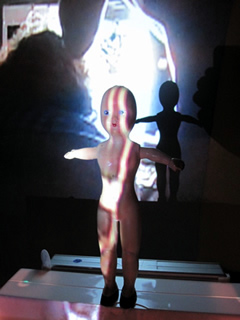 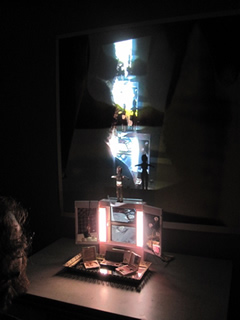 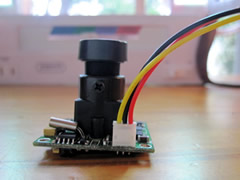 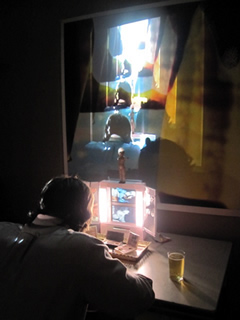 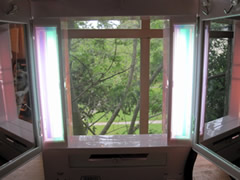 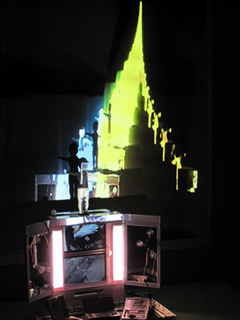 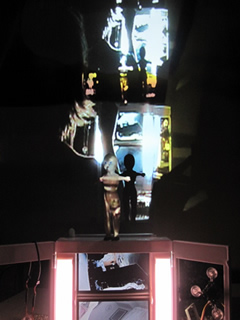 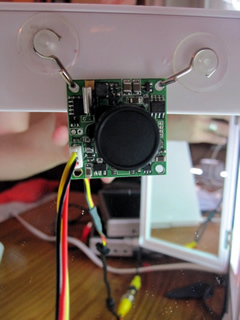  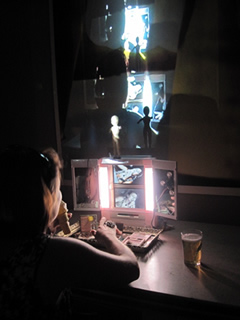 |
Electric Vanity uses digital technology to explore relations of surveillance, particularly self-surveillance and body identity, in today’s multi-layered panoptic world. The primary performance medium is digital technology, which, as Christiane Paul puts it, "implies that the work exlusively uses the digital platform from production to presentation, and that it exhibits and explores that platform’s inherent possibilities” (67). Devising and Constructing I constructed a multi-media sculpture from two 7” LCD screens, commonly found in the backseats of mini-vans, two 1” pinhole cameras, and one lighted make-up vanity mirror. I replaced the center mirror with the LCD screens and used small suction cups to attach the pinhole cameras to the side mirrors. The side mirrors are adjustable, so I was able to position the mirrors with cameras attached to them at different angles, allowing multiple reflections and distorted live-feed images projecting from the LCD screens. Installation The second portion of the project was to install Electric Vanity in a space that would allow for audience interaction with the sculpture. The sculpture was installed on May 4, 2010 in Baton Rouge, Louisiana. Invitations were disseminated via social media, indicating the time and place of the installation. As the audience entered the room a large multi-colored screen print hung on the wall for the live-feed projection. Below the projection was a metal kitchen table from the 1950s with a matching chair, inviting the viewer to sit down. The sculpture was displayed on the table. Additionally, on the table a framed mirror offered make-up to the viewer. Finally, topping the sculpture was an old, broken, and naked baby doll staring at the viewer. As the viewer sat down to engage with the sculpture, the live feed projected the back of the viewer’s body sitting in the chair. Because of the angle, the live feed was able to interact with the video cameras and the mirror installed on the sculpture. The result was a proliferation-effect of the projection. The viewer saw multiple selves and mirrors projected in front of them in their viewing position. The camera placement on the mirrors caused fragmented and disorienting images to appear on the LCD screens in the center of the sculpture. As the audience began interacting with the sculpture they did not know where to focus their attention. It was impossible to discern the sources of their multiple images being projected in multiple places. Viewers became more and more curious about the relationship between their projected images and the cameras and began exploring the sculpture. Most viewers began to play with the positioning of their bodies to see the different projections that would be created as a result. Groundings, Traces, and Homages While devising Electric Vanity, I was influenced by critical studies of surveillance, particularly Michel Foucault’s concept of the panoptic gaze. I wanted to see what happens when people watch themselves watching themselves, conjuring the incessant feedback loops of slef-perception found in social media and network culture. As Christiane Paul explains, “The body and identity have become prominent themes in the digital realm, centering on questions of how we define ourselves in virtual as well as networked physical space. While our physical bodies are still individual, physical “objects’, they have also become increasingly transparent: exact surveillance and identification seem to threaten the idea of individual autonomy.” She continues, “Our virtual existence suggests the opposite of a unified, individual body – multiple selves inhabiting mediated realities.”A common experience of realtime electronic surveillance is a “decentering of the subject brought about by digital technologies” (165). Foucault argues that our bodies become disciplined through repetition of physical action. It is only through the repetition of actions that we learn, and these become "naturalized" in our bodies. Foucault suggests that the impetus to repeat is compelled by the reward and punishment system of panoptic discipline – i.e., by the idea that we act as if we are being scrutinized constantly by an authoritative eye/I who has the power to reward us. At first the disciplinary apparatus is evident, as parents and teachers survey, correct, and praise the young charges for staying on task. Eventually, after intense repetition of the task, the person internalizes the surveillance, makes it her own or becomes subject to it. As a result, she monitors herself and, as pertinent, others too. For this installation, the authoritative eye is initially the beauty industry, present in the vanity mirror that is the skeleton of the sculpture. At this basic level, Electric Vanity is critiquing commercial expectations of beauty and how we, as individuals, internalize body image surveillance through various vanity-performances such as applying make-up and staring at ourselves in the mirror. First, the dominant disciplinary gaze is turned inward, and we begin to be drawn in to self-surveillance. The installation doubly performs surveillance (and the revelation of the surveillance apparatus) with the pinhole cameras attached to the front of the mirrors (directly at eye level), forcing viewers to engage their own image. Calling attention to and subverting the use of surveillance tools is a technique used by other artists. In Security by Julie (1989-90), for example, Julia Scher calls attention to hidden ideologies of everyday objects (surveillance tools) by turning them around on themselves, while much of Dan Graham’s work (e.g., 1974's Present Continuous Pasts) over the past 30 years has experimented with monitors, live feeds, and mirrors. In “Transforming Mirrors: Subjectivity and Control in Interactive Media,” David Rokeby (1995) discusses representation of and communication with ourselves through interacting with mirrors. He explains, “A technology is interactive to the degree that it reflects the consequences of our actions or decisions back to us. It follows that an interactive technology is a medium through which we communicate with ourselves—a mirror.” He also discusses what is reflected back to us and whether or not the mirror images of our selves are distorted and fragmented. Rokeby explains that, “the medium not only reflects back, but also refracts what it is given; what is returned to ourselves, transformed and processed.” Straightforward mirrors provided the reflection and refraction Rokeby describes. However, I did not stop there. I troubled the notion of a single authoratative eye through the use of multiple cameras, projections, and defamiliarizing camera angles. Bretolt Brecht explains defamiliarization as a performance strategy seeking to make the everyday or habitual strange and unfamiliar. Brecht explains, “The artist’s object is to appear strange and even surprising to the audience. He achieves this by looking strangely at himself and his work” (92). Electric Vanity defamiliarizes viewers' perceptual relationships with their bodies by way of unexpected camera angles, wiring to different screens, manipulation of picture quality, and mirror reflections creating infinite distorted feedback. Interacting with Electric Vanity makes our familiar bodies unfamiliar. It makes the seemingly simple and straightforward process of looking disorienting, revealing its taken-for-granted character. A viewer is never able to get an exact mirror reflection of themselves as they peer into the sculpture. It is as if perception itself is put into slippery motion. Everything is always fragmented and distorted. The live feed projections and mirror reflections/refractions combine to make infinite reflection trajectories. The original source of the looking and projection is impossible to fully decipher. It is a visual, embodied enactment of Baudrillard’s theory of simulacra and simulation. The original has so many copies that it is impossible to distinguish one from the other. Edward Shanken explains simulacra and simulation, “Simulations are copies that share many attributes with the concrete original that they represent. By contrast, the term ‘simulacra’ can refer to a form of similarity particular to media culture, wherein distinctions between original and copy become increasingly murky” (43). He explains that the originals that are simulated may no longer exist or, in a digital context, may never have existed at all. For Baudrillard, “Abstraction today is no longer that of the map, the double, the mirror or the concept. . . It is the generation by models of a real without origin or reality: a hyperreal”. Simulacra is especially interesting in regards to the digital image. As Paul explains the inherent lack of physical presence of the digital image, “It has frequently been argued that the digital image is not representational because it is encoded and does not record or reproduce physical reality. While this is debatable on the level of the ‘content’ of the image, which often simulates and represents a physical reality, it is true from the perspective of its reproduction. The digital image consists of discrete, modular elements, pixels that are based on algorithms, mathematical formulas.” In Electric Vanity, I experimented with simulacra of surveillance. However, through audience interaction with the sculpture, viewers find a kind of playful joy in the indistinguishability of surveillance sources, projections, and reflections. The audience takes control over the surveillance tools and uses them to create their own artistic expressions through body placement and movement in relation to the sculpture. The viewer finds different ways of looking, multiple perspectives and multiple selves. Another major theoretical influence on this performance is narcissism. In “The Aesthetics of Narcissism,” Rosalind Kraus examines the role of reflexivity when merging live video feeds with live performances. She explains that, “Unlike the other visual arts, video is capable of recording and transmitting at the same time—producing instant feedback.” Kraus further explains that, “Video’s real medium is a psychological situation, the very terms of which are to withdraw attention from an external object—and Other—and invest it in the Self” (184). The human body is the main subject of video art that deals with the psychological. Consider Monika Fleishmann's Liquid Views (1993), an installation of a screen on a pedestal over a virtual pool of water, which directly calls on the myth of Narcissus in distorting the viewer image of the self. Paul notes, “Liquid Views both translates the corporeal experience of the reflection into the virtual realm and at the same time unveils the function of the interface as a technological device that translates the viewer’s image into the virtual space of reflections” (196). Liquid Views is a conceptual inspiration for Electric Vanity, while Jeffrey Shaw’s The Distributed Legible City (1998) provided inspiration for the intimate mood of the interaction between sculpture and viewer, and Rafael Lozano-Hemmer’s Displaced Emperors installations (1997) provided inspiration for dynamic live-feed projection layered on top of the viewer’s interaction with the sculpture. The baby doll on top of the sculpture is homage to Lynn Hershman’s Tillie the Telerobotic Doll (1995-present) as well as acting as an embodiment of the disciplined ideal. However, the doll herself, is far from perfect. Quite the opposite in fact, she is old and falling apart. |

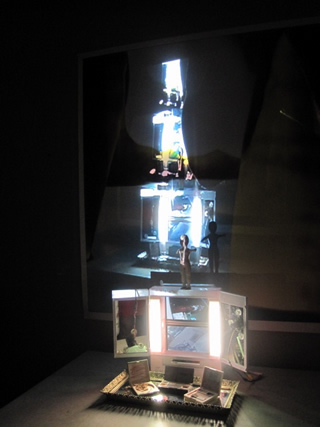
 Works Cited
Works CitedBaudrillard, Jean. Simulacra and Simulation. Trans. Sheila Glaser. Ann Arbor: University of Michigan Press, 1996.
Brecht, Bertolt. Brecht on Theatre. Trans. John Willet. New York: Hill and Wang, 1964.
Fleshmann, Monika, Liquid Views. 1993.
Foucalt, Michel. Discipline and Punish: The Birth of the Prison. Trans. Alan Sheridan. New York: Vintage, 1995.
Graham, Dan. Present Coninuous Pasts(s). 1974.
Hershamn, Lynn. Tillie the Telerobotic Doll, 1995-present.
Krauss, Rosiland, ed. Video: The Aesthetics of Narcissism. Ed. John Hanhardt. Layton: Peregin Smith, 1986.
Lozano-Hemmer, Rafael. Displaced Emperors, 1997.
Paul, Christiane. Digital Art. 2nd ed. New York: Thanmes and Hudson, 2003.
Rokeby, David. "Transforming Mirrors: Subjectivity and Control in Interactive Media." In Critical Issues in Interactive Media, ed. Simon Penny. Albany: State University of New York, 1995.
Scher, Julia. Security by Julia. 1989-90.
Shanken, Edward A. Art and Electronic Media. New York: Phaidon Press, 2009.
Shaw, Jeffrey. The Distributed Legible City, 1998.
» Sarah K. Jackson is a doctoral candidate in Performance Studies at Louisiana State University. Her research and artistic work investigates assemblage art, archival art, and experimental video/film art in and as performance.


